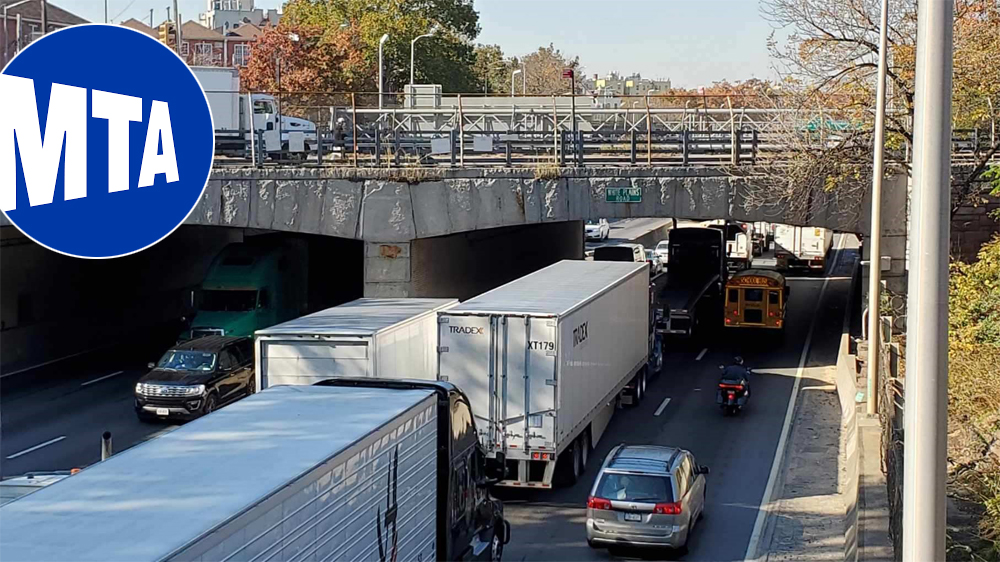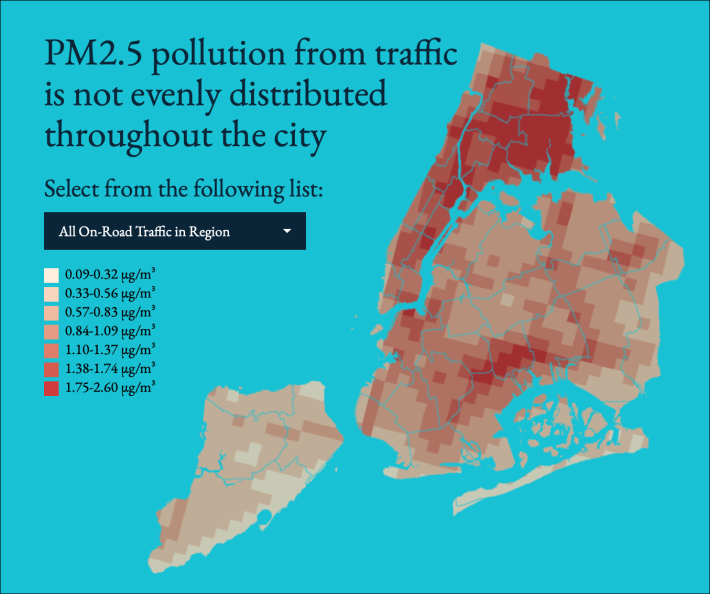The MTA has told the federal government that it will spend tens of millions to mitigate possible air-quality impacts from congestion pricing in the Bronx and other neighborhoods, according to a closely guarded document obtained by Streetsblog.
The document reveals that the MTA is moving swiftly to address concerns from Bronx elected officials, as well as Mayor Adams, after the environmental assessment of the central business district tolling scheme predicted a slight increase in pollution in the Bronx and on Staten Island as some drivers and truckers seek to avoid the Manhattan toll.
The mitigation efforts include:
- electrifying diesel-powered refrigeration trucks at the Hunts Point Market in the Bronx.
- expanding the city’s clean trucks voucher program which helps pay to replace medium- and heavy-duty trucks with electric trucks.
- upgrading parks and green spaces in environmental justice communities.
- installing air filtration units in high schools near highways.
- lowering overnight toll rates, and getting the city DOT to expand its off-hours truck delivery program, in an effort to encourage overnight freight delivery when there is less traffic.
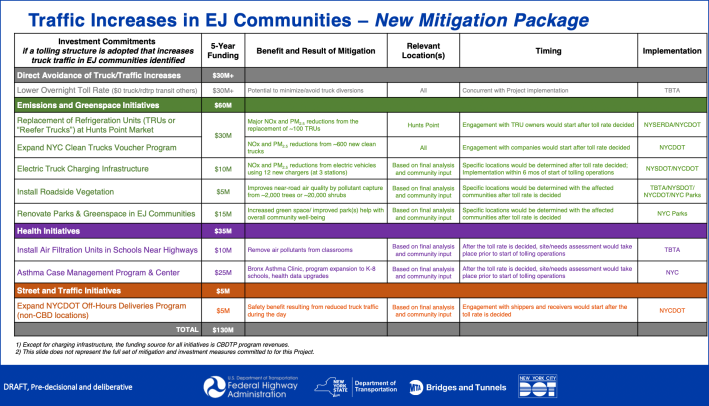
This mitigation package, which the agency claims in its presentation to the federal government “does not represent the full set of mitigation and investment measures,” would cost $130 million over five years, all but $10 million of which will be paid for with congestion pricing revenue. Whether it’s enough to ensure congestion pricing gets the all-clear from Washington remains to be seen, though MTA Chairman and CEO Janno Lieber said in early March that he was optimistic about the program finally moving forward.
The MTA will need the Federal Highway Administration to rule that the agency’s environmental assessment has “No Significant Impact” on the environment in order for the MTA to be able to actually implement congestion pricing without going through a more onerous environmental impact study, which could take even longer than the current process that started at the end of March 2021.
A spokesperson for the Federal Highway Administration said that the federal agency is “diligently working towards a decision” on what to rule on the document, but did not comment on the sweeteners being offered by the MTA.
Advocates love different portions of the plan. Jon Orcutt, a former city DOT official, has long supported variable tolling to encourage overnight deliveries.
“I think it’s great,” said Orcutt. “I’ve always wanted us to push trucks into the evening, like many, many cities around the world do. There’s capacity in the road system, it’s just a time-based thing not a lane-based thing.”
Environmental justice advocates said the overall mitigation was encouraging, but should not obviate the need for state officials to improve air quality more generally.
“It’s great to see that the MTA is committed to investing in strategies that will mitigate any potential impacts on environmental justice communities, particularly in the South Bronx,” said Tri-State Transportation Campaign Executive Director Renae Reynolds. “Environmental justice communities should receive the benefits of an improved mass transit system, as well as the benefit of localized initiatives to reduce and eliminate what have been perpetual harms from the transportation sector. The MTA’s efforts need to be met and exceeded by the state, in order to ensure that the benefits of congestion pricing are felt in communities that have been overburdened for far too long.”
The proposals are specifically focused on mitigating possible air quality impacts from congestion pricing in a few corridors in the city, including The Bronx and Staten Island. In the environmental assessment studying the impact of the traffic toll, MTA researchers suggested that vehicle emissions could rise slightly in the south Bronx and Staten Island if drivers take roads in those areas to get around the congestion pricing charge.
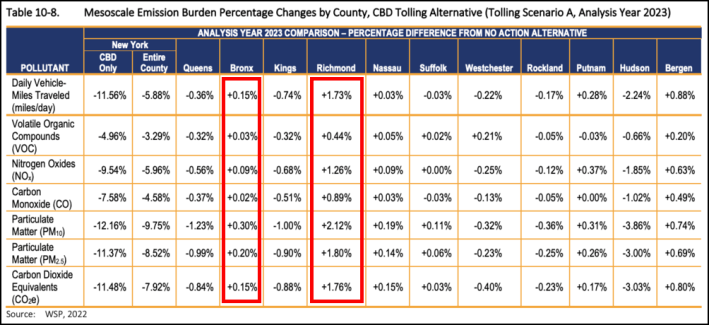
Slight increases in pollution are one thing, but one impact that provoked anger in the Bronx was a finding that truck traffic would increased by 50 to 700 trucks on the Cross Bronx Expressway, depending on which of seven toll scenarios are ultimately chosen (see chart below):
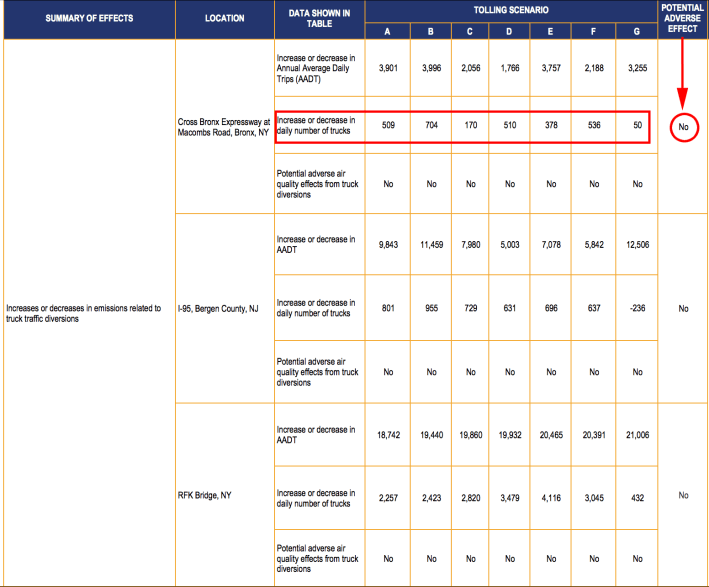
In the environmental assessment, next to the highlighted impacts above, the MTA had written, “No mitigation needed. No adverse effects.” But that assessment — that there was, in effect, no “adverse effects” that would violate National Ambient Air Quality Standards — set off a firestorm of local concern: Rep. Ritchie Torres and City Council Member Amanda Farias said they were adamant that The Bronx could not be a dumping ground as the state moved towards implementing congestion pricing.
The EA noted that the would add electric bus depots in Kingsbridge and Gun Hill Road, which the agency noted would help improve air quality in the Bronx and upper Manhattan, but beyond that, the agency merely promised only to monitor air quality for two years “to determine whether the changes in air pollution can be attributed to changes in traffic” stemming from congestion pricing. And if there were, indeed, changes to air quality, the MTA would then determine “whether more monitoring is necessary.”
But the document obtained by Streetsblog — which has been shown to environmental justice leaders, as well as elected officials, yet has remained under wraps as the federal government prepares to sign off on congestion pricing — goes much further than mere monitoring.
The $130-million, five-year package offers extensive details about how the MTA is showing federal regulators that they are serious about ensuring no impact on The Bronx from congestion pricing. Under the heading, “Investment Commitments if a tolling structure is adopted that increases truck traffic in EJ communities,” the MTA promises it would:
- Eliminate the overnight toll, which would cost the agency more than $30 million.
- Replace refrigeration units at Hunts Point and expanding the clean truck voucher program ($30 million). A commitment to greening Hunts Point is already part of a larger overall program run by the city Economic Development Corporation.
- Add electric truck charing infrastructure in locations to be determined ($10 million, which is the only part of the package that will not be funded with congestion pricing money).
- Add roadside vegetation and renovate parks and green space ($20 million).
- Install air filtration units in schools near highways ($10 million).
- Build an “asthma case management program and center” in The Bronx ($25 million).
It’s unknown what other mitigation offers the MTA is making, and the agency is staying tight-lipped about the process.
“We continue to work for environmental justice, while reducing pollution and traffic in the most congested area of the country, and won’t comment on speculation regarding an ongoing process,” said MTA spokesperson Tim Minton.
It is unclear if the new slate of mitigation promises will satisfy Torres or others, including Mayor Adams, who supports congestion pricing, but has said that his top priority with congestion pricing was to “get it right for the Bronx.”
Mayor Eric Adams, asked about concerns over congestion pricing hurting tourism, says his top concern is to "get it right for the Bronx" and to address environmental concerns raised by Rep. Ritchie Torres: "I think we can get it right."
— Emma G. Fitzsimmons (@emmagf) March 20, 2023
The potential for congestion pricing to burden the south Bronx with even more truck traffic was an unexpected blow to the program, which has had to thread a tight needle from the moment it was first proposed in Albany through the environmental assessment. Even ardent congestion pricing supporters have felt the need to prod the MTA to ensure that the toll doesn’t worsen air quality in one of the areas of the city that bears the burden of car and truck traffic packing a pair of highways.
Torres, a supporter of the idea, held a press conference shortly after the environmental assessment came out to demand mitigation, though he stressed he was critiquing the expected impact of the toll and not the idea itself. A spokesperson for the south Bronx representative said that Torres is still involved in the mitigation talks.
“Our team continues to engage in constructive negotiations with the parties involved over the best strategies for mitigating the environmental impacts on the Bronx, but nothing is final just yet,” said Torres spokesperson Jacob Long.
Of course, mitigating the potential for a small increase in truck traffic in The Bronx does nothing to fix the larger environmental issues in a borough that is already choking on truck traffic. Even if congestion pricing wasn’t implemented, the MTA’s environmental assessment predicts that 27,592 trucks pass through the Cross Bronx corridor every day. As a result, the entire area is burdened by some the city’s worst pollution:
The overall mitigation package even has the support of critics who believe the MTA’s environmental assessment has overestimated the air quality impacts on the South Bronx.
“Just about any policy initiative to cut South Bronx pollution is good and also overdue,” said congestion pricing scholar and traffic analyst Charles Komanoff, who previously argued that region wide traffic reductions would actually result in better overall air quality in the Bronx.
“But tying these programs to congestion pricing is shaky, because traffic volumes and emissions in the South Bronx are going to be less, not more, with congestion pricing. The discourse saying it will be more is an artifact of the MTA’s bungled EA. That said, if it takes a mishandling of the congestion pricing modeling to win long-overdue pollution reductions, so be it.”
